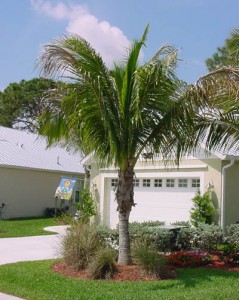Coconut Queen Palm
 Question:
Question:
Do you know of a palm called the Coconut Queen Palm?
Answer from Pat:
Coconut queen palm is a common name, and like all common names, could be for more than one thing and thus easy to confuse. This is why Carl Linnaeus invented botanical names. For example there is a coconut with a double nut. It is the largest seed in the plant kingdom and sexually suggestive jokes are made about it, such as queen coconut palm and other names I’ve heard in Hawaii. The botanical name of the double coconut is Lodoicea maldivica and it probably first came from the Seychelle Islands, not the Maldive Islands where natives often found the nuts washed up on shore. It is not even closely related to the true coconut palm (Cocos nucifera). Previously I sent you the correct botanical name and description of the palm you called cocoanut queen palm (Syagarus romanzoffiana X schzoffel). Queen palms were once incorrectly called cocos palms, but though they are not cocos palms, they are closely related to coconut palms. After that they were called Aracastrum palms for a while, but now they are in the botanical genus Syagarus. Yes, it’s annoying when taxonomists change names on us, but there are reasons for this. I believe your coconut queen palm has a bulbous shape at the bottom of the trunk and the look of a coconut palm. If you get one please describe it and also get the correct botanical name also and find out all about it.


Lodoicea did not wash up on any shore, since it does not float like the coconut. Please check your sources for information.
Please check your sources as well. My source is no less an authority than the late, great, Thomas A. Everett of the New York Botanical Garden who describes how “…these great fruits, which when fresh are heavier than water, sometimes roll into the sea, become partially rotted and then float, on occasion for long distances, to be washed up on distant shores, notably those of the Maldive Islands, India, and Indonesia. They were familiar to man long before their origin was known…. Their scarcity, peculiar shape, and mysterious origin inspired a variety of tales. Some thought them fruits of a giant submarine plant. …It is recorded that Rudolph ll, of the Hapsburgs, offered, unsuccessfully, four thousand gold florins for one…..Not until 1768 was the plant that bore them discovered…” (Quoted from “The New York Botanical Garden Illustrated Encyclopedia of Horticulture” by Thomas A Everett. Vol. 6, page 2053.)
The information Pat offers regarding the “coconut queen” is mostly correct, but leaves out that this is a TRADE NAME for a specific Syagrus hybrid sold by Jungle Jack’s nursery in San Diego (see http://www.junglejacks.com/browse-14084/Palms.html#P02) (this is well known among palm growers and enthusiasts here). Generally speaking, if I saw that name used in connection with palms in the US, I would assume that it would indeed be this hybrid (syagrus romanoffenzia x schizophylla) although it would probably be wise to inquire further. The hybrid is generally understood to have an appearance that is somewhat like a typical queen palm but with a much fuller look (i.e., much greater number of leaves). It is reputed to have a slower growth rate than typical queen palms.
Thank you so much for clarifying this point. This hybrid is a great improvement on common Syagrus palms, which often look straggly due to having too few fronds.
We commercially produce these palms. We are the pollinators. The host palm which is actually the Syagrus schizophylla should be listed first when doing the botanical name. So it would be syagrus Schizophylla x Syagrus Romanoffenzia.
Thank you so much for explaining the correct way to spell the botanical name of coconut queen palm.